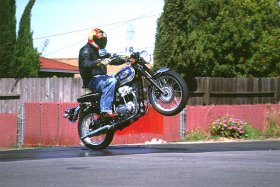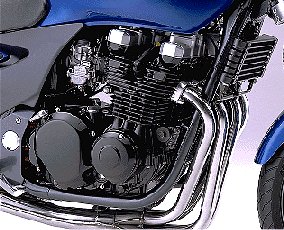 |
|
|
|
 |
W650, ZRX400, ZRX1100, ZZR250, ZZR600, ZZR1100, ER-5, GPZ500, GPX250R, ZR-7, Estrella RS, Voyager 1200 XII, GTR1000 |
|
Off Road |
||||||||||||
 |
 |
 |
 |
|||||||||
| KLE 500 | KLR 250 | KLR 650 | ||||||||||
 |
If you like roads of different quality, then this is the Kawasaki's for you. The KLE 500 have a engine based on the GPZ500, rather unusual for this type of motorbike. KLR250 and KLR 650 have both a air-cooled four-stroke engine and are probably more suited for bad roads than the KLE. The KMX125R have a water cooled two-stroke engine. None of them can be compared with enduro bikes. |
|||||||||||
| KLE 500 close-up. | KLR 650 | |||||||||||
 |
 |
At left the KMX125R |
|
|||||||||
|
Super Sport |
||||||||||
|
Small wit only 250ccm, but not slow. This is an high teck sports bike. It's powered by an inline four and a lot of horse power for it's size. Lighter and more nimble than the other bikes in the ZXR family. |
||||||||||
 |
 |
 |
 |
|||||||
| ZX2-R / ZXR250
|
||||||||||
 |
 |
 |
The ZXR400 have been almost unchanged for several years, still it's one of the most powerful 400ccm sport bikes with 65 hp from it's inline four. |
|||||||
| ZXR400
|
||||||||||
 |
 |
 |
The ZX7 is a replica of Kawasaki's bike in Super bike-championship. It have been around for a while, almost unchanged. A little heavier and some horse power less than it's rivals. |
|||||||
| ZX-7R | ||||||||||
 |
|
Highly updated for the year 2000 - ZX6R a presentation |
|||||||||||
|
In
the competitive 600cc Super Sport class, continual improvements are
necessary to stay ahead of the pack. After taking the lead with the
introduction of an all-new Kawasaki Ninja® ZX-6R sport bike in 1998 and
remaining strong among competitors in 1999, the new 2000 ZX-6R is poised
to have the competition chasing it into the new millennium.
Building
on the success of its predecessors, the 2000 ZX-6R is even more tightly
focused to keep Kawasaki ahead of the pack. A new engine, revised
suspension, frame modifications, lower weight and a mean acronymic fairing
- characterized by dual headlights - help ensure that the ZX-6R will again
lead the way in the highly-competitive 600cc category.
The
compact 599cc power plant now has an all-aluminum cylinder block with
electroplated bores that decreases weight, resists wear and offers
improved heat dissipation. A redesigned pent roof combustion chamber bumps
up the compression from 11.8:1 to 12.8:1 and requires the use of 90-octane
(U.S. standard) gasoline.
Valve
strength is increased in the stem area. The intake manifold is shortened
for increased top-end power and holds a quartet of 36mm downdraft
carburetors equipped with the Kawasaki Throttle Responsive Ignition
Control (K-TRIC) throttle position sensor. Linked to the ignition system,
K-TRIC adjusts ignition timing for all throttle settings to deliver smooth
power and superb throttle response throughout the rev range. A new 16-bit
microprocessor more accurately adjusts timing from more sensors at the
crankshaft. Ignition is delivered by new stick-type coils that are lighter
and more compact than conventional ignition coils.
The
engine breathes through a redesigned Twin Ram Air intake system. Larger
ducts at the front of the fairing create higher pressure to feed cool,
dense air to the air box for more power as speeds rise.
A
four-into-two-into-one exhaust system exits under the curved aluminum
radiator and expels the burnt gasses through a lightweight stainless steel
muffler with aluminum cover. A pre-catalyzer in the exhaust system helps
reduce emissions while allowing maximum tuning capability.
The
cylinder head cover, oil sump pan and clutch cover are now made of
magnesium instead of aluminum to further reduce overall engine weight. A
new lighter crankshaft has larger diameter crankshaft webs to retain the
same great flywheel effect. At the end of the crankshaft is a new
generator that still uses rare-earth magnets for reduced weight and engine
width, but now puts out even more power for the new twin headlights.
The
entire engine acts as stressed member of the short-wheelbase, all-aluminum
perimeter frame, eliminating the need for front frame down tubes in order
to save more weight. The frame main frame rails are constructed of pressed
sheet aluminum that are welded to a cast aluminum steering head and swing
arm pivot section.
A
new extruded aluminum swingarm now features a hexagonal shape with
internal ribbing for reduced weight and a racier appearance. Kawasaki's
UNI-TRAK® rear suspension system has revised linkage ratios for a more
linear curve that is slightly stiffer as the progressive damping and
spring rates are applied to the fully adjustable single shock as the
suspension is compressed. Damping
settings were also revised in the adjustable 46mm cartridge front fork to
match the new rear suspension settings. New, multi-dimensional six-piston
brake calipers with revised pads
grip the dual 300mm front discs for more aggressive and progressive
stopping power. A new rear brake caliper holder is redesigned to reduce
weight.
The
ZX-6R slips through the air easier with its redesigned, wind tunnel-tested
fairing. New lightweight, bright multi-reflector headlights are set above
the larger ram air opening, adding put a whole new look to the ZX-6R's
face. The cockpit also includes a new electronic speedometer that is
thinner and lighter and includes a water temperature gauge, odometer, trip meter
and clock, all digitally displayed in liquid crystal. |
|||||||||||
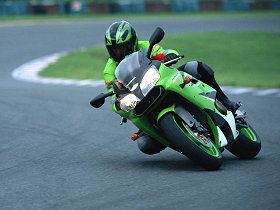 |
|||||||||||
|
The ZX6 for 2000. |
|||||||||||
 |
 |
||||||||||
 |
 |
||||||||||
| European model (big picture) | European model | ||||||||||
 |
 |
||||||||||
| US model | European model | ||||||||||
 |
 |
||||||||||
| European model | Engine | ||||||||||
 |
|
Highly updated for the year 2000 - ZX9R a presentation |
|||||||||||
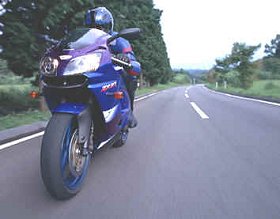 |
Two
years ago the Kawasaki Ninja® ZX-9R revolutionaries the big-bore sport bike
class with its lightweight, compact chassis and incredible performance.
Entering the new millennium, Kawasaki is again poised to up the ante in
the class with a new ZX-9R for 2000.
A
thoroughly revised 899cc engine pumps out more power and provides stronger
acceleration. The light big-bore engine sheds a few more pounds, while
weight was also removed from the frame. The whole package is finished off
with a new aerodynamic fairing derived from the wind tunnel tested ZX-12R.
The
new all-aluminium cylinder block is two pounds lighter than its
predecessor. Each over square cylinder bore now has an electroplated
lining that resists wear and improves heat dispersion. The cylinder head
was reshaped to provide a higher compression ratio, while cam timing and
the cam profile were changed for more torque across the rev range.
Lengthening
the intake tract and exhaust header help smooth the power delivery. New
Keihin 40mm downdraft carburettors deliver improved throttle response and
are equipped with the Kawasaki Throttle Responsive Ignition Control
(K-TRIC) system. Linked to the ignition system, K-TRIC adjusts ignition
timing for all throttle settings. A new 16-bit microprocessor more
accurately adjusts timing from more sensors not only at the carburettors
but also the crankshaft.
The
carburettors breathe through an all-new Ram Air system that has a larger
intake duct for improved intake efficiency. A right-side cam drive allows
an extremely tight angle for the direct-actuation valves to further
enhance intake efficiency.
On
the exhaust side, not only are the header pipes lengthened but they have a
larger diameter too. The four-into-two-into-one system features a
lightweight, all-titanium muffler with the Kawasaki Clean Air System
catalyser. The catalyser allows the engineers to tune the engine for
maximum performance knowing a catalyser will reduce emissions downstream.
The
short-wheelbase aluminium frame has 10mm wider spars and a 12mm longer
steering head pipe for increased rigidity and remarkable handling. A new
aluminium sub-frame is now detachable for easy access to the rear
suspension.
The
new extruded aluminium swing arm now features a hexagonal structure with
ribbing for reduced weight and exceptional rigidity. The hollow swing arm
pivot shaft is larger in diameter for better rigidity and reduced weight.
Kawasaki's Bottom Link UNI-TRAK® system has revised linkage ratios that
provide a more linear progression of damping and spring rates on the
fully-adjustable single shock as the suspension is compressed. A ride
height adjuster has been added to allow riders to fine-tune the chassis to
suit specific conditions.
Up
front the 46mm inverted fork is also recalibrated to match the stiffer
chassis. Fork offset has been reduced for improved handling.
New
front disc brakes have larger diameter 310mm semi-floating discs clamped
by opposed six-piston callipers. The rear brake holder has been redesigned
to save weight. A new rear wheel now has a six-inch wide rim that allows a
wider rear tire for better traction, while both front and rear axles have
increased diameter and are hollow for increased rigidity and light weight. Finishing
off the package is a redesigned fairing incorporating wind tunnel-tested
aerodynamics that enables the ZX-9R to slip through the air. Dual
multi-reflector headlights enhance the sport bike's new predatory styling.
Below the windscreen is a new, more compact electronic
speedometer/odometer with LCD display driven by sensors located on the
countershaft sprocket nut. |
||||||||||
 |
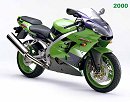 |
||||||||||
| European model | European model | ||||||||||
 |
 |
||||||||||
| European model | European model | ||||||||||
 |
 |
||||||||||
| European model | US model | ||||||||||
 |
 |
||||||||||
| US model | US model | ||||||||||
 |
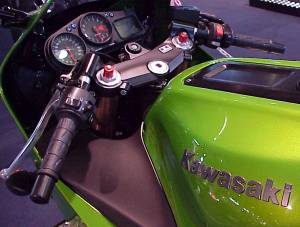 |
 |
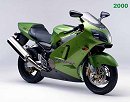 |
 |
|||||||||||
| The new ZX12R, Kawasaki's fastest and strongest bike ever. Claimed to be the fastest in the world, don't like to say it but the Suzuki GSXR1300 was slightly faster. At all the "Kwaker" looks a lot better and has a stronger engine. | ||||||||||||||
| Details form steering head. | ||||||||||||||
 |
 |
 |
 |
 |
||||||||||
| In two different red colour schemes. | Red | An unusual colour, prototype? | Silver | |||||||||||
|
There's
a new flagship in the legendary Kawasaki NINJA® motorcycle series, one
widely expected to set new levels of performance for open-class production
motorcycles. The machine is the all-new Kawasaki NINJA ZX-12R, the most
radical embodiment of race-proven technology that Kawasaki has ever built.
The
ZX-12R follows a long line of sport bikes that set standards others were
forced to follow. From the legendary H1 to the Z1 and through various
open-class NINJA models - such as the ZX-11 that carried the standard for
nearly a decade - the ZX-12R stands ready to redefine performance in a
production motorcycle.
Built
to deliver the lightest weight and highest power-to-weight ratio of any
machine in its class, the ZX-12R combines a compact engine in an all-new
aluminium monocoque chassis, wrapped in slippery aerodynamic bodywork. The
result is exceptional stability and nimble handling in a performance
machine that provides all-day riding comfort.
Using
the same bore/stroke ratio that's at the heart of the class-standard
setting NINJA ZX-9R and ZX-6R, the new ZX-12R engine produces more
horsepower from its 1,199cc displacement than any other machine it its
class. Cast pistons ride in all-aluminium cylinders with electroplated
bores. The pistons are heat treated to prevent heat distortion and have
thin rings for quicker revs.
Four
valves per cylinder are directly actuated by dual overhead cams. A
right-side cam drive allows narrow valve angles for a highly efficient
combustion chamber shape. VX thin wire valve springs are lightweight yet
strong and also help the engine rev quickly. An
added benefit of the right-side cam drive is increased torsion rigidity
for the forged crankshaft, which has a special nitride treatment for extra
strength and durability. A crank-mounted generator with rare-earth magnets
significantly reduces weight and friction. There is also a gear-driven
engine balance shaft to smooth vibration.
The
high-compression engine gets its fuel mixture through a Nippondenso
electronic fuel injection system. Within the 46mm throttle bodies the
injector tips have four holes aimed to spray fuel directly at the intake
valves. Electronic sensors continuously feed the system a variety of
engine and atmospheric data to independently control fuel injection and
ignition for each cylinder. The result is exceptional throttle response
and high output at all engine speeds.
The system
breathes through an all-new frame-integrated Ram Air system for high
intake efficiency, especially at higher speeds. A large scoop projects a
few millimeters in front of the fairing to take advantage of the higher
air pressure just ahead of the leading edge of the fairing, further
increasing intake efficiency. The monocoque frame backbone creates an
efficient air box and a cartridge-type air filter easily slides into the
frame.
Compact
stick-style ignition coils help generate the electrical current to fire
the twin-electrode, long-lasting platinum spark plugs. Burned gasses are
expelled through a four-into-two-into-one exhaust system featuring
stainless steel head pipes and a lightweight, all-titanium muffler. A catalyze
near the muffler helps eliminate unburned hydrocarbons for cleaner
emissions. Kawasaki was among the first to apply a massive, twin-spar aluminum perimeter frame to an open-class production sport bike, and once again it breaks new ground by introducing the aluminum monocoque frame on the ZX-12R. While the twin-spar perimeter frame provides exceptional rigidity, it also adds width to the motorcycle as it wraps around the engine. The ZX-12R's frame eliminates the spars and puts the backbone over the top of the engine. This design significantly reduces overall width for better aerodynamics and a more radically streamlined look while retaining the stiffness and rigidity of a twin-spar frame.
The
ZX-12R's aluminum frame consists of a cast steering head welded to pressed
plates welded to a cast midsection that incorporates the battery case as a
stressed member. A bolt-on aluminum sub-frame supports the seat and tail
section.
Lightweight
aluminum is also used throughout the UNI-TRAK® rear suspension. An
extruded aluminum swingarm uses a linkage system to progressively increase
the damping and spring rate as the suspension is compressed. The single
shock features a piggyback reservoir, threaded spring preload and 20-way
compression and rebound damping adjustment. Rear ride height can also be
adjusted using shims.
Front
suspension is supplied by a 43mm inverted cartridge fork with adjustable
preload, compression and rebound damping. The upper fork crown is cast
aluminum to reduce weight while the lower clamp is forged aluminum for
strength. New 17-inch wheels with hexagonal tri-spokes grace both ends of the ZX-12R. The six-inch wide rear rim is fitted with an ultra-wide 200/50 tire for excellent traction. Braking is accomplished with opposed six-piston calipers gripping the large 320mm diameter dual disc front brakes while a lightweight 230mm single disc is mounted at the rear. A lightweight opposed piston caliper is held to the swing arm. In order to make it as aerodynamic as possible, the ZX-12R spent more time in a wind tunnel during its development phase than any motorcycle in Kawasaki's history. Due to the monocoque chassis design, the ZX-12R is already narrower than any other machine in its class. The front cowl wraps in tighter ahead of the radiator to reduce frontal area and enhance airflow through the engine compartment. Small winglets on either side of the fairing may be mistaken for creating down force when they actually separate airflow around the motorcycle, preventing turbulent air coming off the front wheel from disturbing the laminar airflow along the upper portion of the fairing. Separating the laminar flow and turbulence greatly enhances the fairing's coefficient of drag. To reduce drag there are also small wind deflectors cast into the bottom of the forks that deflect the turbulent air coming off the fork and brakes out and around the lower part of the fairing, where resistance is low, instead of allowing this air to flow inward toward the engine, where resistance is high. Additionally, the ZX-12R has a passenger seat cover that easily attaches to provide a sleek and aerodynamic custom appearance for solo riders. |
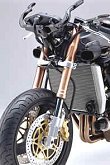
|
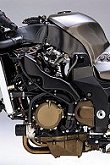 |
||||||||||||
|
Front details. |
Engine. |
|||||||||||||
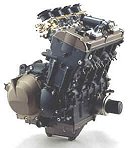
|
 |
|||||||||||||
|
Engine. |
Inside the ZX12R | |||||||||||||
 |

|
|||||||||||||
| Inside the ZX12R |
Front |
|||||||||||||
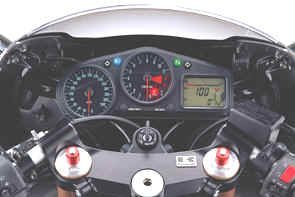
|
||||||||||||||
| Instrument panel. | ||||||||||||||
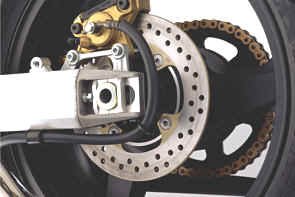
|
||||||||||||||
|
Rear brake details. |
||||||||||||||
 |
||||||||||||||
| Details from under the tank. | ||||||||||||||
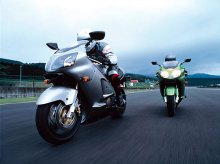 |
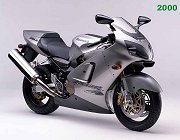 |
 |
 |
|||||||||||
|
High speed touring. |
Silver | Some BIG pictures of the ZX12R | ||||||||||||
 |
This page will be re done, a lot of missing models here.
